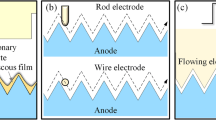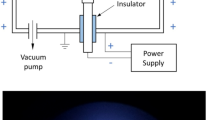Abstract
Zr-based bulk metallic glass (Zr-based BMG) biomedical parts are polished to produce the clinically desired surfaces. In view of this, the present work proposes an environmentally friendly flexible plasma electrolytic polishing (PeP) technique for processing the Zr52.5Cu17.9Ni14.6Al10Ti5 BMG. The stable polishing process and the postelectrochemical composition changes of the Zr-based BMG were investigated, and the surface smoothing mechanism was thus revealed. The roughness and gloss of the polished surface were evaluated to optimize the electrolyte composition ratios and other important process parameters. The crystallization degree and corrosion resistance of the polished surfaces were examined to ensure the applicability of PeP for biomedical Zr-based BMGs. The results showed that a high voltage of 300–380 V led to the development of a steady vapor gaseous envelope and plasma channels for Zr-based BMG polishing. It was noted that the preferential plasma discharge of the high parts (Zr elements) during PeP reacted with the fluoride salt electrolyte and formed a water-soluble zirconium fluoride (ZrF4). Moreover, by using an optimal electrolyte with 3% ammonium salt and 0.1% fluoride salt, the workpiece could be polished efficiently without crystallization. Overall, the surface roughness of the workpiece after the PEP was reduced by 8 times, while the gloss was increased by 10 times and the surface corrosion resistance was enhanced remarkably.











Similar content being viewed by others

Data availability
Not applicable here.
Code availability
Not applicable.
References
Bauer S, Schmuki P, Mark KVD, Park J (2013) Engineering biocompatible implant surfaces: part I: materials and surfaces. Prog Mater Sci 58(3):261–326. https://doi.org/10.1016/j.pmatsci.2012.09.001
Yang K, Shi JR, Wang L, Chen YZ, Liang CY, Yang L, Wang LN (2022) Bacterial anti-adhesion surface design: surface patterning, roughness and wettability: a review. J Mater Sci Technol 99:82–100. https://doi.org/10.1016/j.jmst.2021.05.028
Zeidler H, Boettger-Hiller F, Edelmann J, Schubert A (2016) Surface finish machining of medical parts using plasma electrolytic polishing. Procedia CIRP 49:83–87. https://doi.org/10.1016/j.procir.2015.07.038
Wang WH, Dong C, Shek CH (2004) Bulk metallic glass. Mat Sci Eng R 44(2):45–89. https://doi.org/10.1016/j.mser.2004.03.001
Wang WH (2022) Development and implication enlightenment of amorphous alloys. Bull Chin Acad Sci 37(3):352–359. https://doi.org/10.16418/j.issn.1000-3045.20211208008
Li HF, Zheng YF (2016) Recent advances in bulk metallic glasses for biomedical applications. Acta Biomater 36:1–20. https://doi.org/10.1016/j.actbio.2016.03.047
Meagher P, O’Cearbhaill ED, Byrne JH, Browne DJ (2016) Bulk metallic glasses for implantable medical devices and surgical tools. Adv Mater 28(27):5755–5762. https://doi.org/10.1002/adma.201505347
Sun K, Fu R, Liu XW, Xu LM, Wang G, Chen SY, Zhai QJ, Pauly S (2022) Osteogenesis, and angiogenesis of a bulk metallic glass for biomedical implants. Bioact Mater 8:253–266. https://doi.org/10.1016/j.bioactmat.2021.06.018
Liu LH, Zhang T, Liu ZY, Yu CY, Dong XX, He LJ, Gao K, Zhu XG, Li WH, Wang CY, Li PJ, Zhang LC, Li L (2018) Near-net forming complex shaped Zr-based bulk metallic glasses by high pressure die casting. Mater 11(11):2338. https://doi.org/10.3390/ma11112338
Maroju NK, Yan DP, Xie BY, Jin XL (2018) Investigations on surface microstructure in high-speed milling of Zr-based bulk metallic glass. J Manuf Process 35:40–50. https://doi.org/10.1016/j.jmapro.2018.07.020
Chen SH, Ge Q, Zhang JS, Chang WJ, Zhang JC, Tang HH, Yang HD (2021) Low-speed machining of a Zr-based bulk metallic glass. J Manuf Process 72:565–581. https://doi.org/10.1016/j.jmapro.2021.10.055
Zhang FL, Huang GW, Liu JM, Du ZJ, Wang CY (2021) Grinding performance and wear of metal bond super-abrasive tools in grinding of Zr-based bulk metallic glass. Int J Refract Met H 97(9):105501. https://doi.org/10.1016/j.ijrmhm.2021.105501
Shiou FJ, Loc PH, Dang NH (2013) Surface finish of bulk metallic glass using sequential abrasive jet polishing and annealing processes. Int J Adv Manuf Technol 66:1523–1533. https://doi.org/10.1007/s00170-012-4436-1
Li T, Guo Y, Mizutani M, Xu SL (2021) Surface smoothing of bulk metallic glasses by femtosecond laser double-pulse irradiation. Surf Coat Tech 408:126803. https://doi.org/10.1016/j.surfcoat.2020.126803
Koza JA, Sueptitz R, Uhlemann M, Schultz L, Gebert A (2011) Electrochemical micromachining of a Zr-based bulk metallic glass using a micro-tool electrode technique. Intermetallics 19(4):437–444. https://doi.org/10.1016/j.intermet.2010.10.025
Nestler K, Böttger-Hiller F, Adamitzki W, Glowa G, Zeidler H, Schubert A (2016) Plasma electrolytic polishing—an overview of applied technologies and current challenges to extend the polishable material range. Procedia CIRP 42:503–507. https://doi.org/10.1016/j.procir.2016.02.240
Navickaitė K, Ianniciello L, Tušek J, Engelbrecht K, Bahl CRH, Penzel M, Nestler K, Böttger-Hiller F, Zeidler H (2021) Plasma electrolytic polishing of nitinol: investigation of functional properties. Mater 14:6450. https://doi.org/10.3390/ma14216450
Wang J, Suo LC, Guan LL, Fu YL (2012) Analytical study on mechanism of electrolysis and plasma polishing. Adv Mater Res 472–475:350–353. https://doi.org/10.4028/www.scientific.net/AMR.472-475.350
Belkin PN, Kusmanov SA, Parfenov EV (2020) Mechanism and technological opportunity of plasma electrolytic polishing of metals and alloys surfaces. Appl Surf Sci Adv 1:100016. https://doi.org/10.1016/j.apsadv.2020.100016
Huang Y, Wang CY, Ding F, Yang Y, Zhang T, He XL, Zheng LJ, Li NT (2021) Principle, process, and application of metal plasma electrolytic polishing: a review. Int J Adv Manuf Technol 114:1893–1912. https://doi.org/10.1007/s00170-021-07012-7
Wang J, Suo LC, Guan LL, Fu YL (2012) Optimization of processing parameters for electrolysis and plasma polishing. Appl Mech Mater 217–219:1368–1371. https://doi.org/10.4028/www.scientific.net/AMM.217-219.1368
Belkin PN, Silkin SA, D’yakov IG, Burov SV, Kusmanov SA (2020) Influence of plasma electrolytic polishing conditions on surface roughness of steel. Surf Eng Appl Elect+ 56(1):55–62. https://doi.org/10.3103/S1068375520010032
Zhou CQ, Su HH, Qian N, Zhang Z, Xu JH (2022) Characteristics and function of vapour gaseous envelope fluctuation in plasma electrolytic polishing. Int J Adv Manuf Technol 119:7815–7825. https://doi.org/10.1007/s00170-021-08606-x
Danilov I, Paul R, Hackert-Oschätzchen M, Zinecker M, Quitzke S, Schubert A (2020) Random sequential simulation of the resulting surface roughness in plasma electrolytic polishing of stainless steel. Procedia CIRP 95:981–986. https://doi.org/10.1016/j.procir.2020.02.255
Ji GG, Sun HW, Duan HD, Yang DL, Sun JY (2021) Effect of electrolytic plasma polishing on microstructural evolution and tensile properties of 316L stainless steel. Surf Coat Tech 420:127330. https://doi.org/10.1016/j.surfcoat.2021.127330
Quitzke S, Kroning O, Safranchik D, Zeidler H, Danilov I, Martin A, Böttger-Hiller F, Essel S, Schubert A (2022) Design and setup of a jet-based technology for localized small scale plasma electrolytic polishing. J Manuf Process 75:1123–1133. https://doi.org/10.1016/j.jmapro.2022.01.064
Spica A, Roche J, Arurault L, Horville M, Rolet J (2021) Evolution of model roughness on quasi-pure aluminum during plasma electrolytic polishing. Surf Coat Tech 428:127839. https://doi.org/10.1016/j.surfcoat.2021.127839
Smyslova MK, Tamindarov DR, Plotnikov NV, Modina IM, Semenova IP (2019) Surface electrolytic-plasma polishing of Ti-6Al-4V alloy with ultrafine-grained structure produced by severe plastic deformation. IOP Conf Ser: Mater Sci 461:012079. https://doi.org/10.1088/1757-899X/461/1/012079
Kusmanov SA, Tambovskiy IV, Silkin SA, Nikiforov RV, Belkin PN (2020) The effect of plasma electrolytic polishing on the surface properties of titanium alloy after plasma electrolytic chemical-thermal treatment. IOP Conf Ser: Mater Sci 919:022028. https://doi.org/10.1088/1757-899X/919/2/022028
Aliakseyeu Y, Bubulis A, Minchenya V, Korolyvo A, Niss V, Janutiene KR (2021) Plasma electrolyte polishing of titanium and niobium alloys in low concentrated salt solution based electrolyte. Mechanika 27(1):88–93. https://doi.org/10.5755/J02.MECH.25044
Zhou CQ, Qian N, Su HH, Zhang Z, Ding WF, Xu JH (2022) Effect of energy distribution on the machining efficiency and surface morphology of Inconel 718 nickel-based superalloy using plasma electrolytic polishing. Surf Coat Tech 441:128506. https://doi.org/10.1016/j.surfcoat.2022.128506
Zeidler H, Böttger T, Schröder S, Schneider M, Lämmel C, Sahr F, Tardelli J, Exbrayat L (2022) Analysis of plasma-electrolytic polishing process initiation. Procedia CIRP 108:782–786. https://doi.org/10.1016/j.procir.2022.03.121
Seo B, Park H, Park KB, Kang H, Park K (2021) Effect of hydrogen peroxide on Cr oxide formation of additive manufactured CoCr alloys during plasma electrolytic polishing. Mater Lett 294:129736. https://doi.org/10.1016/j.matlet.2021.129736
Vopát T, Podhorský Š, Sahul M, Haršáni M (2019) Cutting edge preparation of cutting tools using plasma discharges in electrolyte. J Manuf Process 46:234–240. https://doi.org/10.1016/j.jmapro.2019.08.033
An S, Foest R, Fricke K, Riemer H, Fröhlich M, Quade A, Schäfer J, Weltmann K, Kersten H (2021) Pretreatment of cutting tools by plasma electrolytic polishing (PEP) for enhanced adhesion of hard coatings. Surf Coat Tech 405:126504. https://doi.org/10.1016/j.surfcoat.2020.126504
Wang CY, He XL, Li NT, Gao K, Zhang T, Zheng LJ (2018) Patent’s name is amorphous alloy polishing solution and amorphous alloy polishing method. Invention Number is CN108660504
Sinha S, Badrinarayanan S, Sinha APB (1986) Interaction of oxygen with Zr76Fe24 metglass: an X-ray photoelectron spectroscopy study. J Less-common Met 125:85–95. https://doi.org/10.1016/0022-5088(86)90082-2
Hu MZC, Payzant EA, Booth KR, Rawn CJ, Hunt RD, Allard LF (2003) Ultrafine microsphere particles of zirconium titanate produced by homogeneous dielectric-tuning coprecipitation. J Mater Sci 38(18):3831–3844. https://doi.org/10.1023/A:1025900804268
Nefedov VI, Salyn YV, Chertkov AA, Padurets L (1974) The X-ray electronic study of the distribution of electron density in transition element hydrides. Zh Neorg Khim 19:1443–1445
Bosman HJM, Pijpers AP, Jaspers AWMA (1996) An X-ray photoelectron spectroscopy study of the acidity of SiO2-ZrO2 mixed oxides. J Catal 161:551–1445. https://doi.org/10.1006/jcat.1996.0217
Jolley JG, Geesey GG, Hankins MR, Wright RB, Wichlacz PL (1989) Auger electron and X-ray photoelectron spectroscopic study of the biocorrosion of copper by alginic acid polysaccharide. Appl Surf Sci 37(4):469–480. https://doi.org/10.1016/0169-4332(89)90505-9
Strohmeier BR, Leyden DE, Field RS, Hercules DM (1985) Surface spectroscopic characterization of Cu/Al2O3 catalysts. J Catal 94(2):514–530. https://doi.org/10.1016/0021-9517(85)90216-7
Veprek S, Cocke DL, Kehl S, Oswald HR (1986) Mechanism of the deactivation of Hopcalite catalysts studied by XPS, ISS, and other techniques. J Catal 100(1):250–263. https://doi.org/10.1016/0021-9517(86)90090-4
Salvati L, Makovsky LE, Stencel JM, Brown FR, Hercules DM (1981) Surface spectroscopic study of tungsten-alumina catalysts using X-ray photoelectron, ion scattering, and Raman spectroscopies. J Phys Chem 85(24):3700–3707. https://doi.org/10.1021/j150624a035
Sleigh C, Pijpers AP, Jaspers A, Coussens B, Meier RJ (1996) On the determination of atomic charge via ESCA including application to organometallics. J Electron Spectrosc Relat Phenom 77(41):41–57. https://doi.org/10.1016/0368-2048(95)02392-5
Colón JL, Thakur DS, Yang CY, Clearfield A, Martini CR (1990) X-ray photoelectron spectroscopy and catalytic activity of α-zirconium phosphate and zirconium phosphate sulfophenylphosphonate. J Catal 124(1):148–159. https://doi.org/10.1016/0021-9517(90)90111-V
Wang JG, Choi BW, Nieh TG, Liu CT (2000) Crystallization and nanoindentation behavior of a bulk Zr–Al–Ti–Cu–Ni amorphous alloy. J Mater Res 15(3):798–807. https://doi.org/10.1557/JMR.2000.0114
Siddaiah A, Ramachandran R, Menezes PL (2021) Tribocorrosion: fundamentals, methods, and materials. Academic Press, London, San Diego, Cambridge, Oxford
Funding
This work was supported by the National Natural Science Foundation of China (grant no. 51735003 within the framework of the Key Program) and the Guangdong Science and Technology Department of China (grant no. 2019B030302010 within the framework of the Key Basic and Applied Research Program).
Author information
Authors and Affiliations
Contributions
All authors contributed to the research and review of the paper. Chengyong Wang developed the conception of the study. Chengyong Wang and Feng Ding performed the analyses and wrote and revised the paper. Yangjia Li participated in writing the paper. Tao Zhang, Xiaolin He, and Yu Huang worked on the experiments and data analyses. Xuguang Zhu and Kuan Gao performed the analysis with constructive discussions.
Corresponding author
Ethics declarations
Ethics approval
Not applicable.
Consent to participate
Not applicable.
Consent for publication
Not applicable.
Conflict of interest
The authors declare no competing interests.
Additional information
Publisher's note
Springer Nature remains neutral with regard to jurisdictional claims in published maps and institutional affiliations.
Rights and permissions
Springer Nature or its licensor (e.g. a society or other partner) holds exclusive rights to this article under a publishing agreement with the author(s) or other rightsholder(s); author self-archiving of the accepted manuscript version of this article is solely governed by the terms of such publishing agreement and applicable law.
About this article
Cite this article
Wang, C., Ding, F., Li, Y. et al. Plasma electrolytic polishing for improving the surface quality of zirconium-based bulk metallic glass. Int J Adv Manuf Technol 124, 2079–2093 (2023). https://doi.org/10.1007/s00170-022-10588-3
Received:
Accepted:
Published:
Issue Date:
DOI: https://doi.org/10.1007/s00170-022-10588-3



